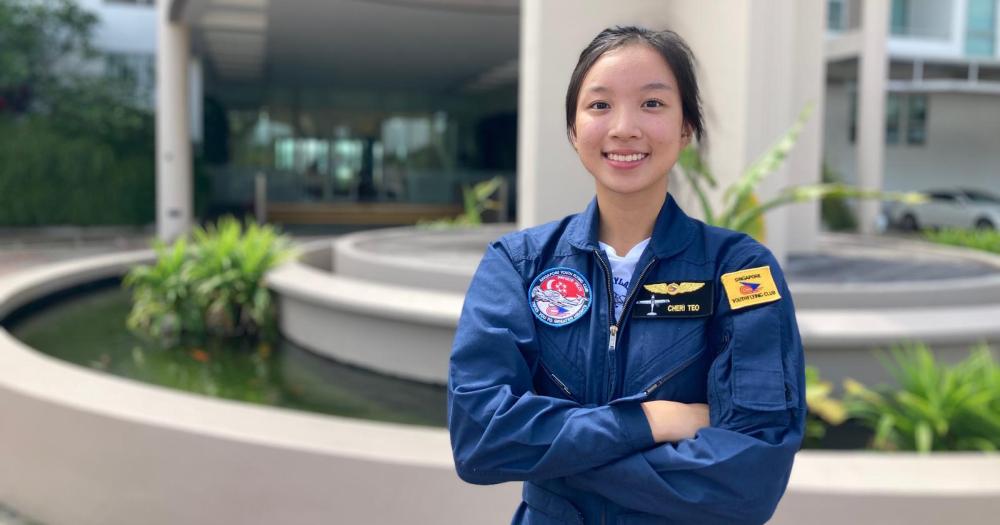Cheri Teo remembers visiting the inaugural Singapore Airshow in 2008 as a six-year-old.
"Back then, I still didn't know what was going on," she says, smiling at the memory, which included other select details such as the fact that her siblings were there with her, that her father had brought them there, and that the big aircraft really left an impression.
Qualified pilot and Air Force-pilot-to-be
Today, Teo is on track to be trained as an Air Force pilot, having passed out from Basic Military Training (BMT) just days before she sat down with Mothership to share about her journey with the Singapore Youth Flying Club (SYFC).
It was an intense year of studying, training, and flying, which ultimately led to her getting a pilot's license at age 17 — before she could even learn how to drive.
It was in fact that very prospect — of being able to pilot a plane before learning how to drive — that helped SYFC appeal to Teo, who recalls that her reaction to that amusing notion was: "dang, that's kinda cool."
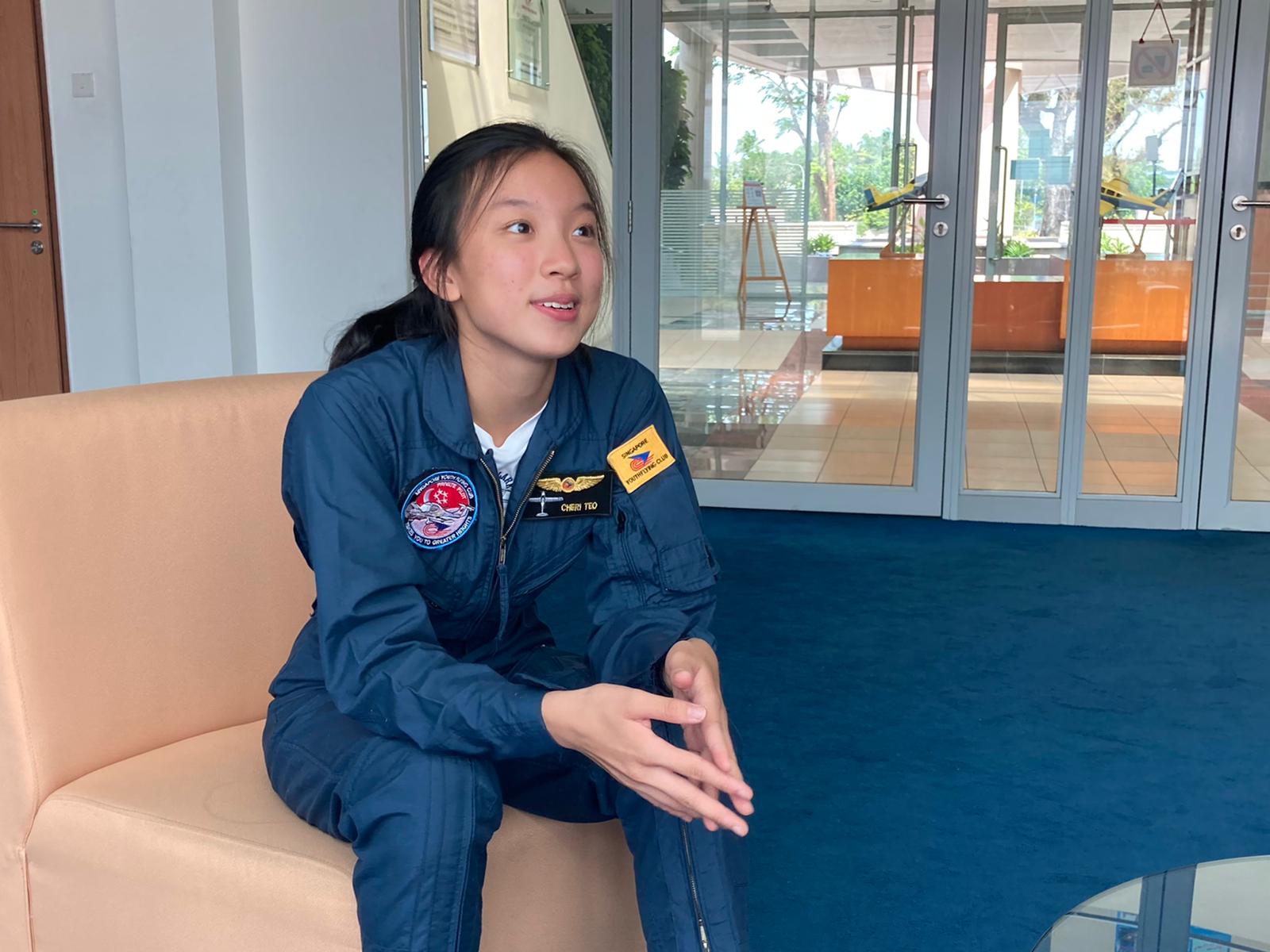 Teo is the third member of her family to join the RSAF, after her father (who served as a Ground-Based Air Defence officer) and her brother (who pilots an Unmanned Aerial Vehicle (UAV)). Photo by Nigel Chua.
Teo is the third member of her family to join the RSAF, after her father (who served as a Ground-Based Air Defence officer) and her brother (who pilots an Unmanned Aerial Vehicle (UAV)). Photo by Nigel Chua.
Teo says that she decided to give SYFC a shot in late 2018, when she was coming to the end of her time at Raffles Girls School. Teo recalls the gentle influence that her father — a former RSAF officer — had on her decision to sign up with SYFC, over the years.
Whenever they drove past an airport, he would drop casual mentions about it to her, telling her that if she was keen, she could perhaps one day be a pilot.
Joining the SYFC
Teo started out in the first phase of SYFC's Basic Flying Course in November 2018, fresh out of secondary school.
As part of Phase I of the course, Teo was taken up into the skies as a passenger on a training flight (also known as a "sortie").
What's it like to fly?
"From up there, everything really looks so small," says Teo, who still remembers being surprised at how she could see the distinctive shape of Marina Bay Sands, as well as her own house.
That first taste of flight left a lasting impression.
"Once you've tasted flying, it really changes everything, you can't go back. It's really, really fun. You really want to continue flying after that."
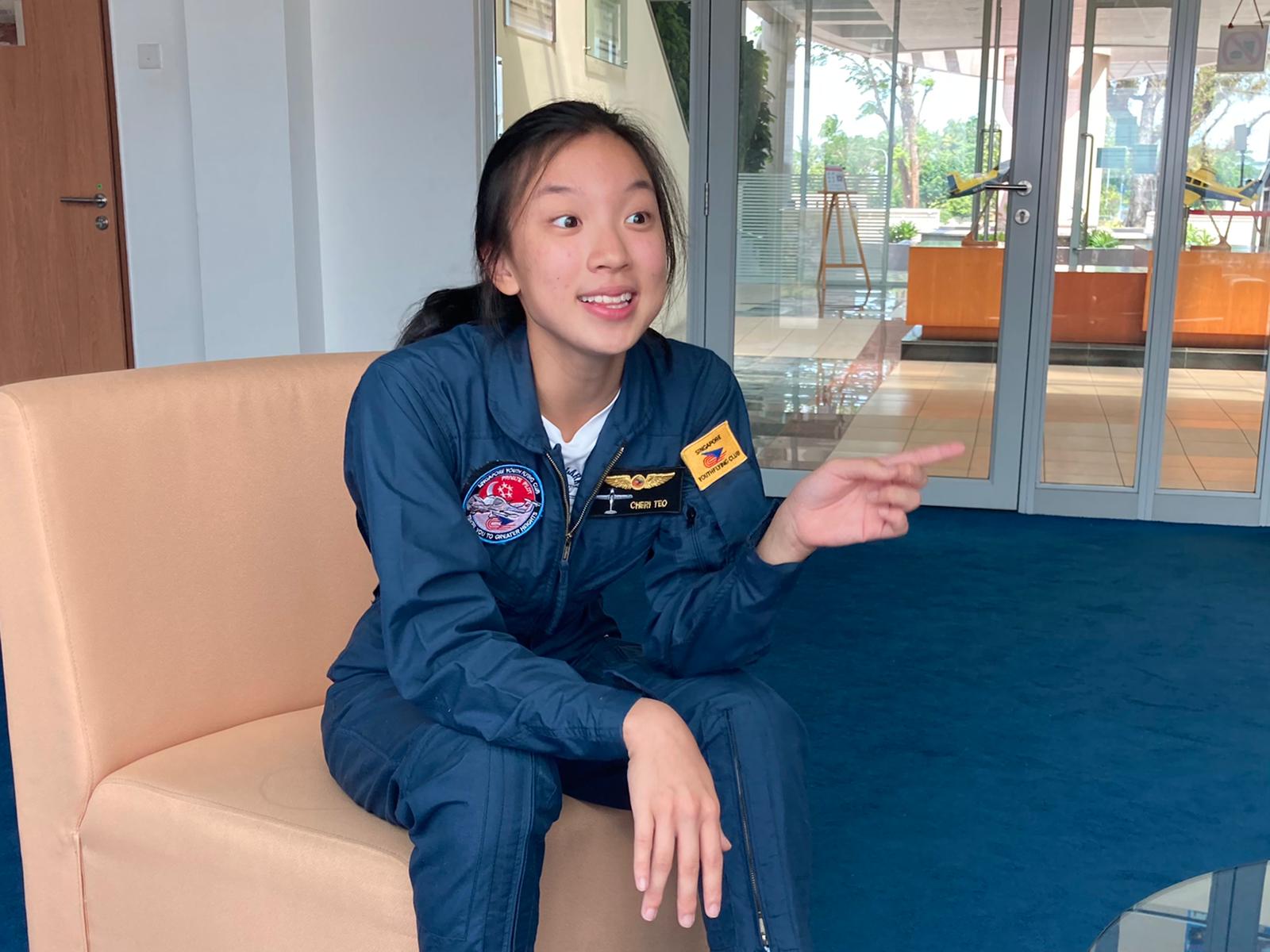 "I saw a rainbow also," gushes Teo, recalling her first of many training flights in vivid detail. Photo by Nigel Chua.
"I saw a rainbow also," gushes Teo, recalling her first of many training flights in vivid detail. Photo by Nigel Chua.
Rollercoaster weightlessness
Teo, asked to describe the experience of flying a plane, pauses for a while, thinking, before launching into an effusive spiel about the thrill of lift-off:
"Ooh! There's a very nice feeling I want to describe — it's taking off.
Ok when you take off, you have to pull the joystick backwards, right? And the aircraft just lifts off. And it feels like when you're on a rollercoaster and you're at the top of the rollercoaster and there's that 'lifted' feeling, right?
You feel that, and it's really really nice."
Similarly, when taking a plane up higher into the sky, Teo describes being pressed into her seat by the g-force, a feeling quite similar to that of being at the bottom of a rollercoaster.
And when the plane is descending sharply, there is a moment of weightlessness, Teo says, where one could drop a pen in the cockpit and watch it float momentarily.
Aircraft becomes an extension of your body
Teo waxes philosophically about two seemingly-paradoxical notions she holds about flying.
On one hand, she says, flying embodies freedom — being able to fly wherever you wish, an experience more like swimming than driving, as the aircraft becomes an extension of one's body, where pilot and plane glide smoothly through the air — albeit within the confines of Singapore's highly-restricted airspace.
On the other hand, being in the pilot's seat is a weighty responsibility, Teo says, explaining that flying is just as much about "confidence, and command and control."
Very different from flying commercial
The massive size of commercial aircraft, Teo says, means that flying on a passenger airline simply incomparable to the experience of flying in the "relatively-mini aircraft" that SYFC participants train in.
Taxiing onto the runway, Teo says, made her feel "quite tiny" in comparison to the other planes at Seletar Airport — much larger private jets.
From the cockpit of the small DA40 plane, "the runway really feels very very vast, very wide," says Teo.
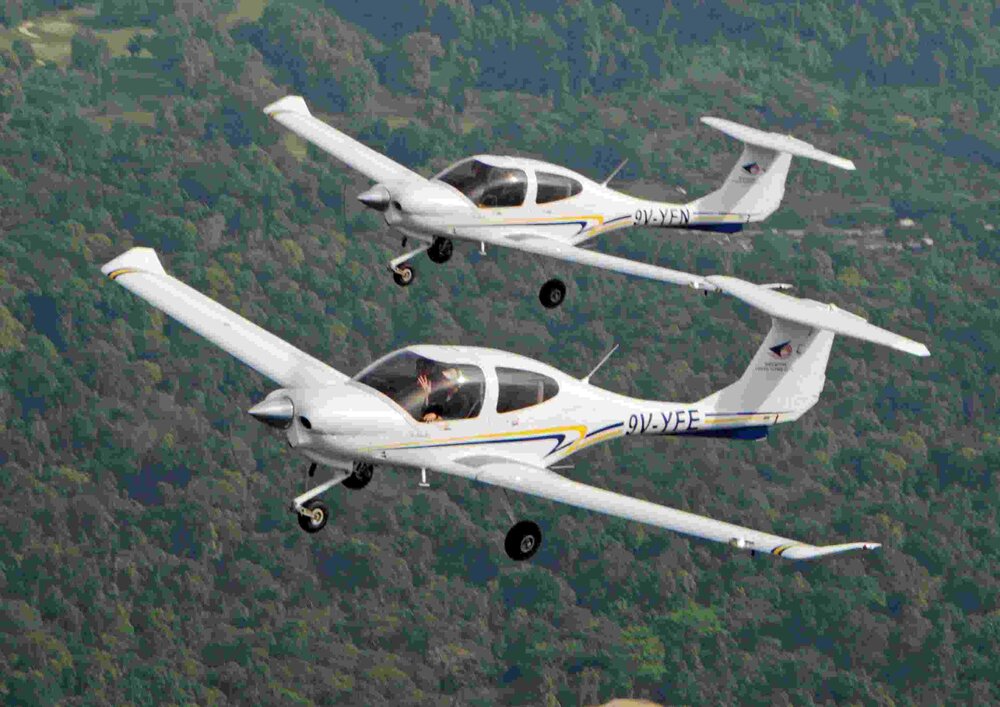 The DA40 aircraft runs on a single engine, and has just four seats. Photo via SYFC's website.
The DA40 aircraft runs on a single engine, and has just four seats. Photo via SYFC's website.
Flying solo for the first time
Teo describes one of her most memorable experiences — her first solo flight — as being "very very nice".
Sitting alone in the cockpit was somewhat nerve-wracking, Teo admits, recalling a stillness and quiet that filled the empty aircraft as she prepared herself for that first solo.
"If anything goes wrong, you're on your own, right?" says Teo, matter-of-factly, before quickly adding: "But nothing ever goes wrong, because they train you well enough."
Teo shares that the lead-up to that first solo flight requires students to repeatedly run through the exact sequence of actions, to the point that during the actual flight, muscle memory takes over.
Furthermore, she says, any remaining nervousness quickly got overwhelmed by excitement.
Biggest fear was not living up to others' expectations
If anything, Teo's toughest struggles were with a different kind of fear — that of not living up to others' expectations.
"I really feel so bad when other people have expectations for me, and I'm unable to live up to those expectations," says Teo.
One wonders if Teo — a high-flier who wrapped up her time in Raffles Girls School with a perfect GPA in seven of her subjects — has much experience with letting anyone down.
Teo, a self-confessed perfectionist, says that it was in SYFC that she realised that perfection is not always attainable.
Faced with the very high standards set by her instructors, Teo's initial response was to be "really harsh on [her]self in making sure [she] never ever disappointed my instructors," a mindset which she soon learned was too idealistic — after all, there was no way to perfect every single sortie, given the dynamic nature of flying.
The roots of this idealistic mindset lay in how Teo had thought that she needed to be good at something before considering it as something she should do.
Therefore, mistakes and failure to meet expectations made her question whether she should even be in the programme.
After discovering that her fellow students were putting similarly unrealistic expectations on themselves, Teo and her batchmates "talked each other out of it", learning instead to "trust the process", and to accept the mistakes that they would inevitably make as part of the process of learning.
This important mindset change, as well as the building up of resilience through the entire process, are among Teo's most cherished lessons from her time at SYFC.
What does it take to become a pilot?
The first solo is a pivotal milestone in the SYFC Flying Course, as flying alone is an opportunity given to a select few students who "demonstrate competence" in Phase II of the course.
Even out of the ones who get to fly solo at the end of Phase II, "only the outstanding ones" are recommended to proceed to the third and final phase.
Teo had committed herself fully to going through the programme, and rode the bus from school to SYFC nearly every day after her classes, despite the fact that she was also in the midst of 'A' Level exam preparations.
Teo does not mince her words as she recalls the biggest challenges she faced: needing to get through thick textbooks which covered concepts that she had never been exposed to before, and being put in high-pressure situations by her instructors, who sought to train their students to be able to respond to any exigencies while in the air, through what Teo describes as "tough love".
Ironically, it was not the rigorous academic and technical demands of the Flying Course that saw Teo nearly getting dropped from the programme.
Rather, it was something quite outside her control.
Nearly getting dropped
In March 2019, at the end of the first phase of the Flying Course, Teo went for a second medical screening to confirm that she could progress to the second phase.
To her surprise, she failed.
This was on account of an issue with her eyesight — specifically, that the degree of her astigmatism had crept up past the maximum threshold.
"I was so sure that I wasn't ever going to step foot into an aircraft ever again," says Teo ruefully.
"I felt very helpless because it wasn't something that I could change. It was just my eyes."
The next two weeks would be the toughest part of her journey, as she grappled with the very real prospect that the past four months of intensive studying and training would be her last experiences with flying.
Teo got through the worst of the emotions with the support of friends in school, only to hear that her medical results had been reconsidered.
She would be given a second chance — provided that she took better care of her eyes from then on.
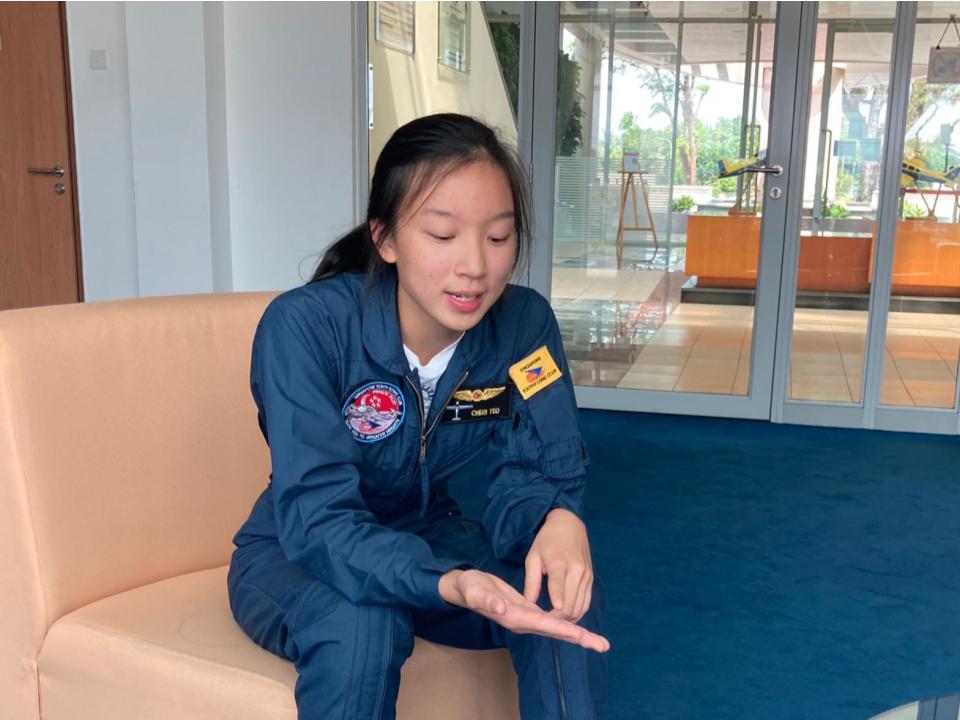 "It was like a rollercoaster; I was the most elated that I had ever felt when I heard the news that I could get back in. And I was also the saddest that I had ever felt... when they said I got kicked out," says Teo of her failed medical test in March 2019. Photo by Nigel Chua.
"It was like a rollercoaster; I was the most elated that I had ever felt when I heard the news that I could get back in. And I was also the saddest that I had ever felt... when they said I got kicked out," says Teo of her failed medical test in March 2019. Photo by Nigel Chua.
The experience taught her to appreciate the privilege of being a part of the course, and not to take it for granted.
Team effort
Teo, in a 2018 interview with The New Paper as a finalist of their "New Face" modelling competition, said that her proudest moment in her life till then was getting accepted into SYFC, because of how she'd had to clear a tough entrance interview, and very stringent medical tests.
Today, however, her new proudest moment is not that she has graduated from SYFC, but that she reached the end of the journey together with her peers and instructors.
"I really wouldn't have made it this far without them," she says.
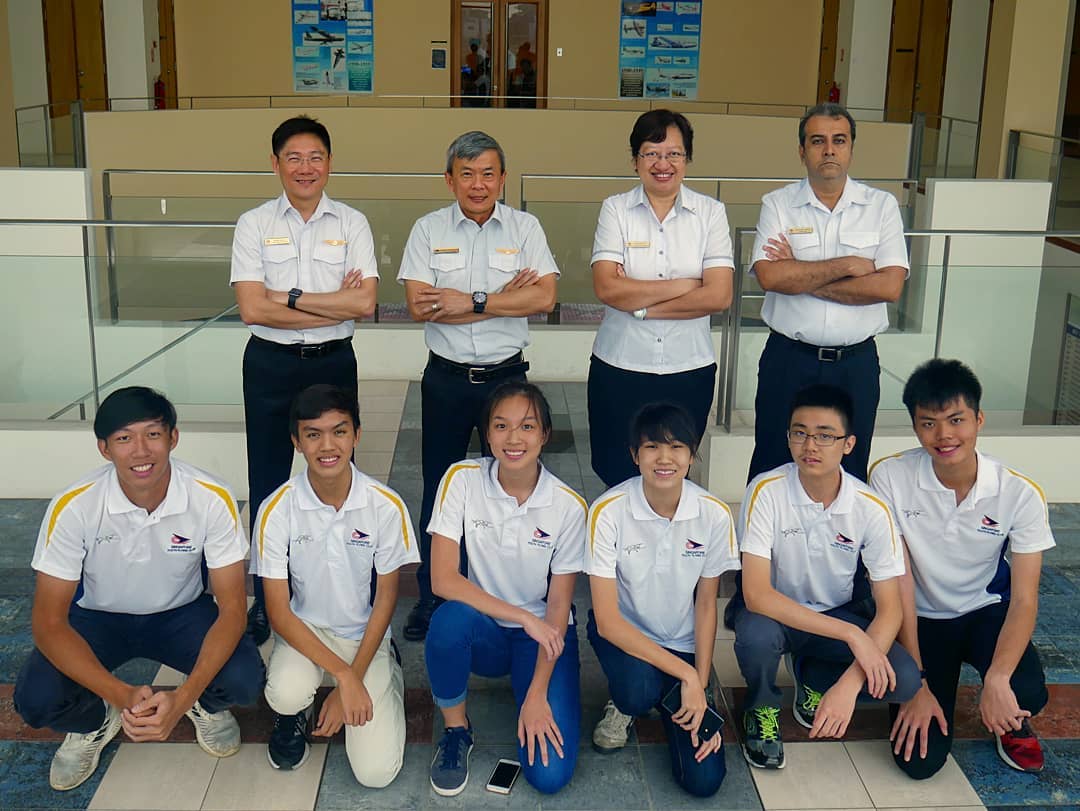 Teo with her fellow coursemates from the PAC-18 full time course. Photo via Singapore Youth Flying Club on Facebook.
Teo with her fellow coursemates from the PAC-18 full time course. Photo via Singapore Youth Flying Club on Facebook.
"It's really this... wholesome feeling of the team effort that really helped each individual get to the end point, which is the attainment of the Private Pilot's License."
With mild amusement at herself, Teo says, "I'm trying not to make it sound cheesy, but that's really how it is."
It's clear that Teo is well-connected in SYFC after spending so many days there over the course of that one year, and she greets each person she encounters with a cheery smile.
At one point, a SYFC staff member briefly interrupts us as he needs to get a photo of the interview location for an unrelated matter, and Teo jokingly tells him that she wants to be in the photo, striking a pose with both hands in the air, before moving out of the way obligingly.
Observing the easy rapport that Teo has with all of the SYFC staff we encounter that day, it's no wonder that Teo has so much to say about the camaraderie that she experienced during the course, something she considers much more important than her own personal achievement.
Teo also acknowledges the important role that her parents played, by providing emotional support and the occasional ride home, among other little things.
For example, after a visualisation exercise in her room, which SYFC trainees call "mental flying", Teo opened her eyes and found a plate of cut fruits that had been prepared by them.
Who should join SYFC?
Teo recommends SYFC to "everyone", even those who don't already have an interest in aviation, as one's interest in the field can grow along the way.
And Teo has a special message for females, in particular, explaining that while there are more males than females among SYFC's students, her own experience was that students and instructors alike saw her as equal, and did not give her (nor her male classmates) special treatment on account of gender.
"To any of the female youths in Singapore who are considering flying... I think they should just go for it."
After all, Teo says, "the aircraft doesn't recognise whether you're female or male, they just recognise that you're a pilot."
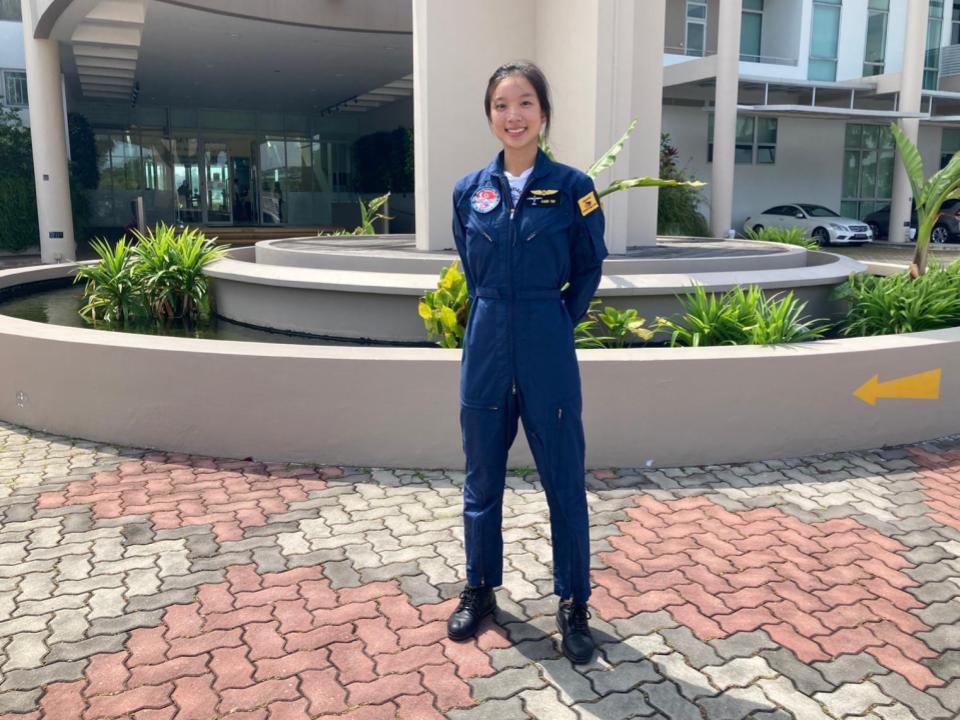 Photo by Nigel Chua.
Photo by Nigel Chua.
Stories of Us is a series about ordinary people in Singapore and the unique ways they’re living their lives. Be it breaking away from conventions, pursuing an atypical passion, or the struggles they are facing, these stories remind us both of our individual uniqueness and our collective humanity.
If you like what you read, follow us on Facebook, Instagram, Twitter and Telegram to get the latest updates.
